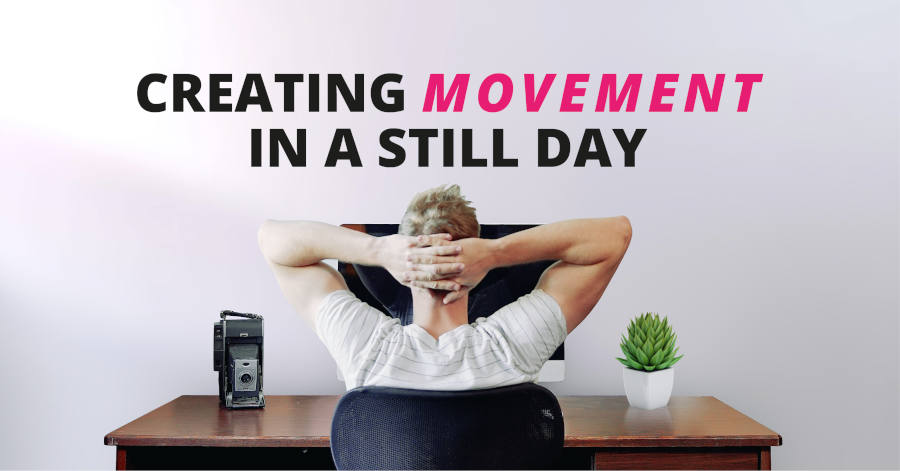
Creating Movement in a Still Day
Since our lives were changed unrecognisably in the early Spring of 2020 due to what is now known as a pandemic caused by the Covid-19 virus, many of us have been working from home.
At first, this might have felt like a novelty. But now so many of us realise that working from the kitchen table or perched on a corner of the sofa has multiple downsides. Such as an increased likelihood of developing soreness in the muscles and joints. (1)
Even if we have a proper office ‘set up’ at home, working from home can be lonely and unstimulating. It can also be difficult to set physical and emotional boundaries between work life and home life.
However, one of the major bonuses of this new way of working is that there’s no commute. There are no late or crowded trains, traffic jams or grumpy commuters to deal with. But on the flip side of that, it also means that we’re not necessarily moving as much.
A significantly lower number of steps!
If you’ve noticed your step count is much lower than it used to be, you’re not alone. As working from home becomes our norm, we’re exercising less. (2) We’re no longer walking to stations or stepping off the bus early to grab a coffee before walking the rest of the way to the office.
Instead, we’re stepping across the hallway to the spare room. Plus, whilst we’re working, we no longer need to get up to speak to colleagues, walk to the meeting room or nip out to get lunch. We’re probably starting work earlier at home, and working later, since there are no real boundaries, meaning that we’re sitting still for even longer.
Basically, we’re confined to the same four walls, all week long, with little real movement. But movement is so important to our physical and mental health as we discuss in our article, The 5 pillars of physical and mental wellness during a pandemic.
So here’s our tips for getting more movement into your day when you’re working from home.
Walking “to and from work”
Start each day by walking around the block or somewhere in your neighbourhood for 20 minutes or so. Not only does this help to create a mental divide between work and home, it’ll get you moving and it helps to stimulate the mind ready for work. (3)
To decompress after work, do the same, just as if you were walking to the station to come home. During which time, you can switch off from work mode to home mode.
Jump around like no one’s watching!
Over half of all the messages that your spinal cord sends to your brain are to do with movement. So if at the end of the day you’re feeling lethargic then it could be because you haven’t moved much during the day, and your brain is lacking stimulation.
Set a regular reminder to get up and perform some squats, lunges and star jumps to add movement to your day. Aim for a few sets of ten, as often as you like throughout the day. Research shows that even short bursts of exercise are beneficial to our health. (4)
This will also help to relieve gluteal amnesia, otherwise known as dead butt syndrome…
Consider a stand up desk
Stand up desks are designed to be higher than a normal desk, so that you can still use them in the same way, only you’ll be standing instead of sitting. You’ll automatically be creating more movement in your day. Desks that can easily switch between seated and standing are also available.
Standing whilst working has shown to be beneficial in terms of reducing back pain (5) improving the mood and reducing stress and fatigue. (6)
Make lunchtime count
It’s tempting to skip lunchtime altogether and eat al desko, but lunchtime is the perfect opportunity to get some movement in. Take the time to go for a walk, complete an online workout or go for a run.
Exercise boosts productivity and creativity too, meaning that you escape the afternoon slump altogether and feel proud at the end of a productive day full of achievements! (7)
1. org.uk. 2021. Survey reveals the mental and physical health impacts of home working during Covid-19. [online] Available at: https://www.rsph.org.uk/about-us/news/survey-reveals-the-mental-and-physical-health-impacts-of-home-working-during-covid-19.html [Accessed 27 May 2021].
2. Bevan, S., Mason, B. and Bajorek, Z., 2021. Homeworker Wellbeing Survey. [online] Employment-studies.co.uk. Available at: https://www.employment-studies.co.uk/sites/default/files/resources/summarypdfs/IES%20Homeworker%20Wellbeing%20Survey%20-%20Interim%20Findings.pdf [Accessed 27 May 2021].
3. Armstrong, G.-F.G.B., 2018. How Exercise Affects Your Brain. Scientific American. Available at: https://www.scientificamerican.com/article/how-exercise-affects-your-brain/ [Accessed May 27, 2021].
4. Saint-Maurice, P., Troiano, R., Matthews, C. and Kraus, W., 2021. Moderate‐to‐Vigorous Physical Activity and All‐Cause Mortality: Do Bouts Matter? [online] Journal of the American Heart Association. Available at: https://www.ahajournals.org/doi/full/10.1161/JAHA.117.007678 [Accessed 27 May 2021].
5. DW;, T.A.A.K.B.A.O.N.D., Breaking up workplace sitting time with intermittent standing bouts improves fatigue and musculoskeletal discomfort in overweight/obese office workers. Occupational and environmental medicine. Available at: https://pubmed.ncbi.nlm.nih.gov/25168375/ [Accessed May 27, 2021].
6. JR;, P.N.P.K.A.S.L.M.P., Reducing occupational sitting time and improving worker health: the Take-a-Stand Project, 2011. Preventing chronic disease. Available at: https://pubmed.ncbi.nlm.nih.gov/23057991/ [Accessed May 27, 2021].
7. Coulson, J.C., McKenna, J. & Field, M., 2008. Exercising at work and self‐reported work performance. International Journal of Workplace Health Management. Available at: https://www.emerald.com/insight/content/doi/10.1108/17538350810926534/full/html [Accessed May 27, 2021].


